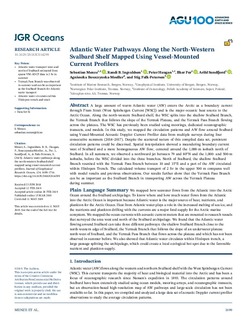| dc.contributor.author | Menze, Sebastian | |
| dc.contributor.author | Ingvaldsen, Randi Brunvær | |
| dc.contributor.author | Haugan, Peter M. | |
| dc.contributor.author | Fer, Ilker | |
| dc.contributor.author | Sundfjord, Arild | |
| dc.contributor.author | Beszczynska-Moeller, Agnieszka | |
| dc.contributor.author | Falk-Petersen, Stig | |
| dc.date.accessioned | 2019-06-18T13:09:22Z | |
| dc.date.available | 2019-06-18T13:09:22Z | |
| dc.date.created | 2019-06-07T09:44:04Z | |
| dc.date.issued | 2019 | |
| dc.identifier.citation | Journal of Geophysical Research - Space Physics. 2019, 124 (3), 1699-1716. | nb_NO |
| dc.identifier.issn | 2169-9380 | |
| dc.identifier.uri | http://hdl.handle.net/11250/2601232 | |
| dc.description.abstract | A large amount of warm Atlantic water (AW) enters the Arctic as a boundary current through Fram Strait (West Spitsbergen Current [WSC]) and is the major oceanic heat source to the Arctic Ocean. Along the north‐western Svalbard shelf, the WSC splits into the shallow Svalbard Branch, the Yermak Branch that follows the slope of the Yermak Plateau, and the Yermak Pass Branch flowing across the plateau. The WSC has previously been studied using moorings, dedicated oceanographic transects, and models. In this study, we mapped the circulation patterns and AW flow around Svalbard using Vessel‐Mounted Acoustic Doppler Current Profiler data from multiple surveys during four consecutive summers (2014–2017). Despite the scattered nature of this compiled data set, persistent circulation patterns could be discerned. Spatial interpolation showed a meandering boundary current west of Svalbard and a more homogeneous AW flow, centered around the 1,000‐m isobath north of Svalbard. In all summers, we observed a northward jet between 79 and 80°N and the 1,000‐ and 500‐m isobaths, before the WSC divided into the three branches. North of Svalbard, the shallow Svalbard Branch reunited with the Yermak Pass Branch between 10 and 15°E and a part of the AW circulated within Hinlopen Trench. The calculated volume transport of 2 Sv in the upper 500 m compares well with model results and previous observations. Our results further show that the Yermak Pass Branch can be as important as the Svalbard Branch in transporting AW across the Yermak Plateau during summer. | nb_NO |
| dc.language.iso | eng | nb_NO |
| dc.title | Atlantic Water Pathways Along the North-Western Svalbard Shelf Mapped Using Vessel-Mounted Current Profilers | nb_NO |
| dc.type | Journal article | nb_NO |
| dc.type | Peer reviewed | nb_NO |
| dc.description.version | publishedVersion | nb_NO |
| dc.source.pagenumber | 1699-1716 | nb_NO |
| dc.source.volume | 124 | nb_NO |
| dc.source.journal | Journal of Geophysical Research - Space Physics | nb_NO |
| dc.source.issue | 3 | nb_NO |
| dc.identifier.doi | 10.1029/2018JC014299 | |
| dc.identifier.cristin | 1703358 | |
| cristin.unitcode | 7431,0,0,0 | |
| cristin.unitname | Havforskningsinstituttet | |
| cristin.ispublished | true | |
| cristin.fulltext | original | |
| cristin.qualitycode | 2 | |
